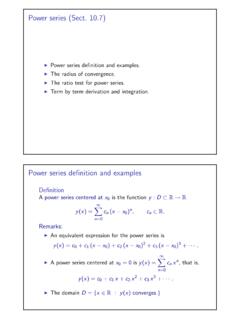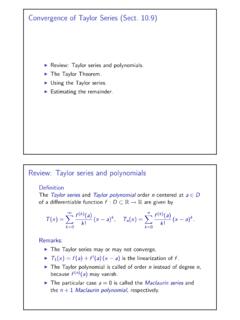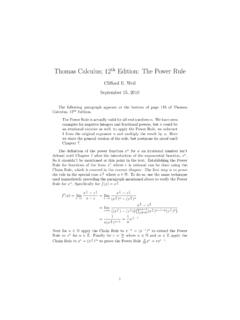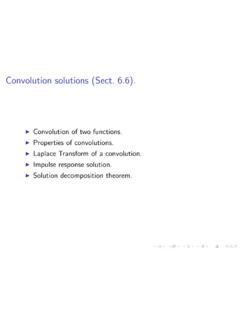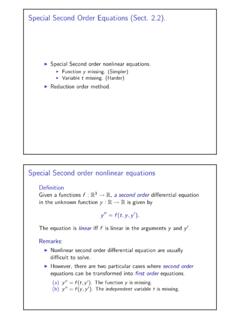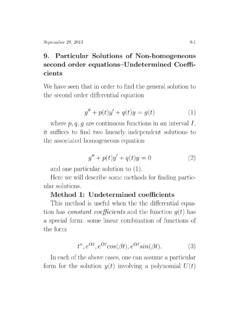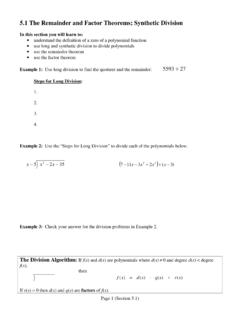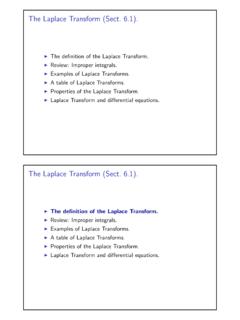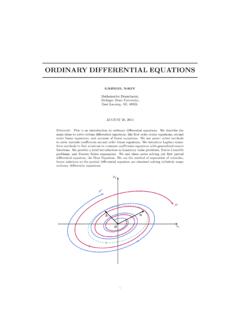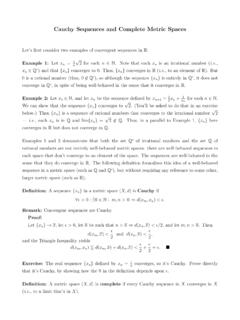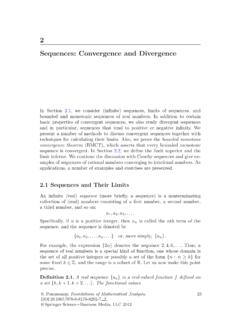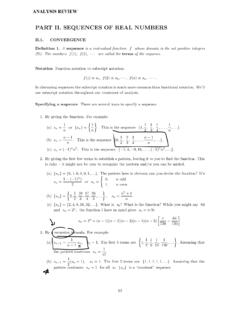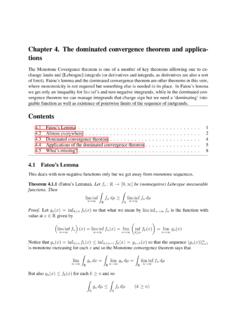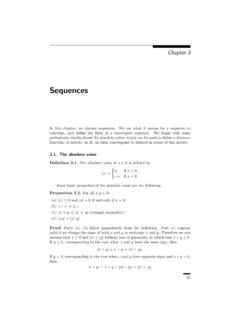Transcription of Sequences and Series
1 Chapter 2 Sequences and The Limit of a SequenceDefinition a function whose domain this function is denoted byf, then the valuesf(n) (n N) determine the sequence uniquely, and vise-versa. Therefore,a sequence is usually denoted by(a1,a2,a3,a4, ) or (an) n=1,wherean=f(n) forn this course we only study Sequences of real numbers; namely functionsf:N of the following are common ways to describe a sequence .(i) (1,12,13,14, ),(ii) (nn+1) n=1,(iii) (an), wherean= 2nfor alln N,(iv) (xn), wherex1= 2 andxn+1=xn+12. This is the induction way or recursion wayto define a the difference between a sequence (an) and a set{an:n N}:(( 1)n) n=1= ( 1,1, 1,1, 1,1, ) is a sequence , having infinitely many terms (whichcan have repeated values);{( 1)n:n N}={1, 1}is simply a set of two elements, not a countable set nor asequence;(c) = (c,c,c,c, ) is the constant sequence ;{c}is the set of single ( convergence of a sequence ).A sequence (an) is said toconvergeto areal numbera(called thelimitof the sequence ) if, for every number >0, there exists anN Nsuch that whenevern Nit follows that|an a|<.
2 In this case we write eitherliman=aoran a sequence (an) does not converge to any real number, we say (an) a real numbera Rand positive number >0 the intervalV (a) = (a ,a+ )is the Sequences and SeriesA topological way to say liman=ais the following: Given any -neighborhoodV (a)ofa, there exists a place in the sequence after which all of the terms are inV (a).Easy Fact:lim(c) =cfor all constant Sequences (c). definition of liman=aquantifies the closeness ofantoaby an arbi-trarily given >0 and the truth of this closeness for all terms after a termaN. It is oftenthe case the smaller is the largerNis needed to be. However the heart of the matter inthis definition is that no matter how small >0 is there always exists such an integerNvalidating the for a proof ofliman=a Let >0 be arbitrary (not 1 or110005, but arbitrary; no numerical values areknown). Try to solve the inequality|an a|< to determine how to choose anN Nsothat this inequality holds for alln step usually requires the most work,almost of all of which is done prior to actually writing the formal proof.
3 Now show that theNfound actually works; namely for alln Nthe inequality|an a|< indeed (n+ 1n) = +1nanda= the inequality|an a|= n+ 1n 1 =1n< is the same asn >1 .The existence ofN Ncan be deduced by the AP(i): there alwaysexists anN Nsuch thatN >1 .The actual proof goes as >0 be arbitrary. By the AP(i), there exists anN Nsuch thatN >1 .Thenwhenevern Nwe have 1/n 1/N < and hence|an a|= n+ 1n 1 =1n< .Therefore, by definition, liman= 1. The Algebraic and Order Limit TheoremsDefinition sequence (an) isbounded above(orbounded below) if there existsa numberMsuch thatan M(oran M) forn sequence (an) isboundedifit is both bounded above and bounded above; namely, there exists a numberM >0 suchthat|an| Mfor alln convergent sequence is (an) there exists anN Nsuch that|an a|<1 n , by the triangle inequality,|an|=|(an a) +a| |an a|+|a| |a|+lfor alln letM= max{|a1|,|a2|, ,|aN 1|,|a|+ 1}. The Algebraic and Order Limit Theorems3 Then|an| Mfor alln proves (an) is bounded.
4 Theorem (Algebraic Limit Theorem).Letliman=aandlimbn= (i)lim(can) =ca, for allc R;(ii)lim(an+bn) =a+b;(iii)lim(anbn) =ab;(iv)lim(an/bn) =a/b,providedbn6= 0andb6= :We can use these formulas only when the limitslimanandlimbnboth only the product and quotient of (iii):Note thatanbn ab=anbn anb+anb ab=an(bn b) + (an a) , by the triangle inequality,|anbn ab| |an(bn b)|+|(an a)b|=|an||bn b|+|an a||b|.In order to make|anbn ab|< , it suffices to make each of the two terms on the right ofabove inequalities< (an) converges, it is bounded and so|an| M( n N)for some numberM > the two terms are bounded as follows:|an||bn b| M|bn b|,|an a||b| |an a|(|b|+ 1)(here changing|b|to|b|+ 1 to make it positive).Now, given arbitrary >0,since (an) a, we haveN1 Nsuch that|an a|< 2(|b|+ 1) n (bn) b, we haveN2 Nsuch that|bn b|< 2M n max{N1,N2}(orN=N1+N2). Then, for thisN, whenevern N, it followsthat|an a|< 2(|b|+ 1),|bn b|< 2 Mand hence|an a||b| |b|2(|b|+ 1)< 2,|an||bn b| M|bn b| M2M= , it follows that whenevern N|anbn ab| |an||bn b|+|an a||b|< /2 + /2 =.
5 Hence (anbn) of (iv):Note thatanbn ab=ban abnbnb=b(an a) +a(b bn) Sequences and SeriesFirst, using (bn) b6= 0, with =|b|/2>0, there exists anN1 Nsuch that|bn b|<|b|/2 for alln , by a form of the triangle inequality,|bn| |b| |bn b| |b|/2for alln all suchn,|bnb| |b|2/2 and anbn ab |b||an a||bnb|+|a||b bn||bnb| 2|b||an a|+2|a||b|2|bn b| 2|b||an a|+2|a|+ 1|b|2|bn b|.Then we proceed as above to selectN2andN3inNsuch that2|b||an a|< /2 whenevern N2and2|a|+ 1|b|2|bn b|< /2whenevern , letN= max{N1,N2,N3}.Then, whenevern N, it follows that anbn ab < /2 + /2 = . Theorem (Order Limit Theorem).Assume bothliman=aandlimbn=bexist. Ifan bnfor alln N, whereN Nis some number, thena use the proof by contradiction. Supposea > lim(an bn) =a b >0.(The following argument was used above in the proof of (iv) of the theorem.) Using =a b2>0, we have anN Nsuch that|(an bn) (a b)|< =a b2 n b < an bn< a b+ for alln b =a b2>0; this impliesthatan bn> a b >0 for alln > bnfor alln N.
6 This is a contradictionto the assumptionan bnfor alln we must havea b. (Exercise ) Letxn 0 for alln Nand lim(xn) =x. Showlim( xn) = must havex 0 by the order limit theorem. We prove the statement in 1:x= that xn< if and only ifxn< 2:x > this case| xn x|=|xn x| xn+ x |xn x| x. The monotone convergence Theorem and a First Look at Infinite The monotone convergence Theorem and a First Look at InfiniteSeriesDefinition sequence (an) is calledincreasingifan an+1for alln Nanddecreasingifan an+1for alln sequence is said to bemonotoneif it is eitherincreasing or ( monotone convergence Theorem(MCT)).If an increasing (or de-creasing) sequence is bounded above (or below) then it converges. In fact, the limit equalsthe supremum (or the infimum) of the set consisting of the terms of the only prove the theorem for the increasing sequence . Let (an) be an increasingsequence and, for some numberM,an Mfor alln the setS={an:n N}.
7 ThenSis nonempty and bounded above (withMbeing an upper-bound). So by theAoC,a= supSexists. We now prove liman= an upper-bound forS,an a n the other hand, given arbitrary >0, sincea= supS, by the Lemma before, thereexists an elementaN Ssuch thata < , by the monotonicity ofan,an aN> a n above inequalities, we havea < an a < an+ ; that is,|an a|< for alln liman=a. The MCT is useful for the study of infinite Series because it asserts the convergenceof a sequence without explicit mention of the actual limit; of course, without needing tochecking the definition involving arbitrary > (Exercise ) Show that the sequence 2, 2 2, 2 2 2, converges and find the then-th term of this sequence ; that is,a1= 2,a2= 2 2, .Wehavean+1= 2an;hencea2n+1= 2an, n= 1,2,3, .Use induction and we can show that 2 an 2 andan an+1for alln (an) is bounded and increasing. Therefore, by the MCT, liman=aexists. order limit theorem says 2 a 2.
8 Since lim(an+1) =a, taking the limit on both sidesofa2n+1= 2an, we havea2= 0, it follows thata= 2; that is, liman= 2. Limit Superior and Limit Inferior*.This is covered in Exercise (an) be a bounded sequence . Letxn= inf{ak|k n}= inf{an,an+1,an+2, },yn= sup{ak|k n}= sup{an,an+1,an+2, }.Then (xn) is increasing and bounded, and (yn) is decreasing and bounded. Hence, by theMCT,both limxn=xand limyn= Sequences and SeriesDefinition (Limit superior and limit inferior).Definelim infan= limxn=x,lim supan= limyn=yto be thelimit inferiorandlimit superiorof sequence (an), has thatlim infan lim ,limanexists if and onlyiflim infan= lim The first statement is easy from theorder limit theoremand theinequality( )xn an yn n N,wherexn,ynare defined as Assume lim infan= lim supan=l; hence limxn= limyn= , from ( ) andtheSqueeze Theorem,liman= Now assume lim infan<lim two numbersa,bsuch that lim infan<a < b <lim limxn< aandxnis increasing, it follows thatxk< a k , asxk= inf{an|n k}, k N, nk ksuch thatank< , k N, mk ksuch thatamk> ( )amk ank> b a k show that (an) does not converge.
9 For a contradiction, suppose that (an) ,for =b a4>0, N Nsuch that|an l|<(b a)/4 n N; thenmk, nk k N. Hence|amk l|<b a4and|ank l|<b implies|amk ank| |amk l|+|ank l|<(b a)/2,contradicting with ( ) above. This completes the proof. A First Look at Infinite (bn) be a sequence . Aninfinite seriesof (bn) isa formal expression of the form n=1bn=b1+b2+b3+ .The correspondingsequence of partial sums(sn) is defined bysn=b1+b2+ +bn n say the Series n=1bnconverges(toB R) if limsn=B. In this case, we write n=1bn=BandBis called the value or the sum of the infinite Series . If a Series does notconverge then we say that ifbn 0 then its partial sum sequence (sn) is increasing. Therefore, in thiscase, to show the Series to converge, by the MCT, it suffices to show that (sn) (i) Consider n= thatbn=1n2<1n(n 1)=1n 1 1n n Subsequences and the Bolzano-Weierstrass Theorem7We havesn=b1+b2+ +bn<1 +(11 12)+(12 13)+ +(1n 1 1n)= 2 1n< is, (sn) is bounded above; hence (sn) converges, so does the infinite Series n= we do not know the value of the Series .
10 (ii) Consider theharmonic Series : n= show this Series diverges by showing its partial sum sequence (sn) is not bounded. Notesn= 1 +12+13+ + 1 +12+(13+14)>1 +12+(14+14)= 1 +12+ can look ats8to sees8> general, look ats2kand we find thats2k= 1 +12+(13+14)+(15+ +18)+ +(12k 1+ 1+ +12k)>1 +12+(14+14)+(18+ +18)+ +(12k+ +12k)= 1 +12+ 2 14+ 4 18+ + 2k 1 12k= 1 +k 12=k+ (sn) can not be bounded above by any number. This proves that the harmonic Subsequences and the Bolzano-Weierstrass TheoremWe know that every convergent sequence is bounded; however, every bounded sequencemay not be convergent, , (( 1)n) is a bounded sequence , but diverges. But part of thesequence consists of only number 1 and, as a sequence itself, does converge. This is in factvalid for all bounded Sequences . But we need to use (an) be a sequence , and letn1< n2< n3< be an increasingsequence of natural numbers. Then the sequence (ank) k=1= (an1,an2,an3, )is called asubsequenceof (an).

